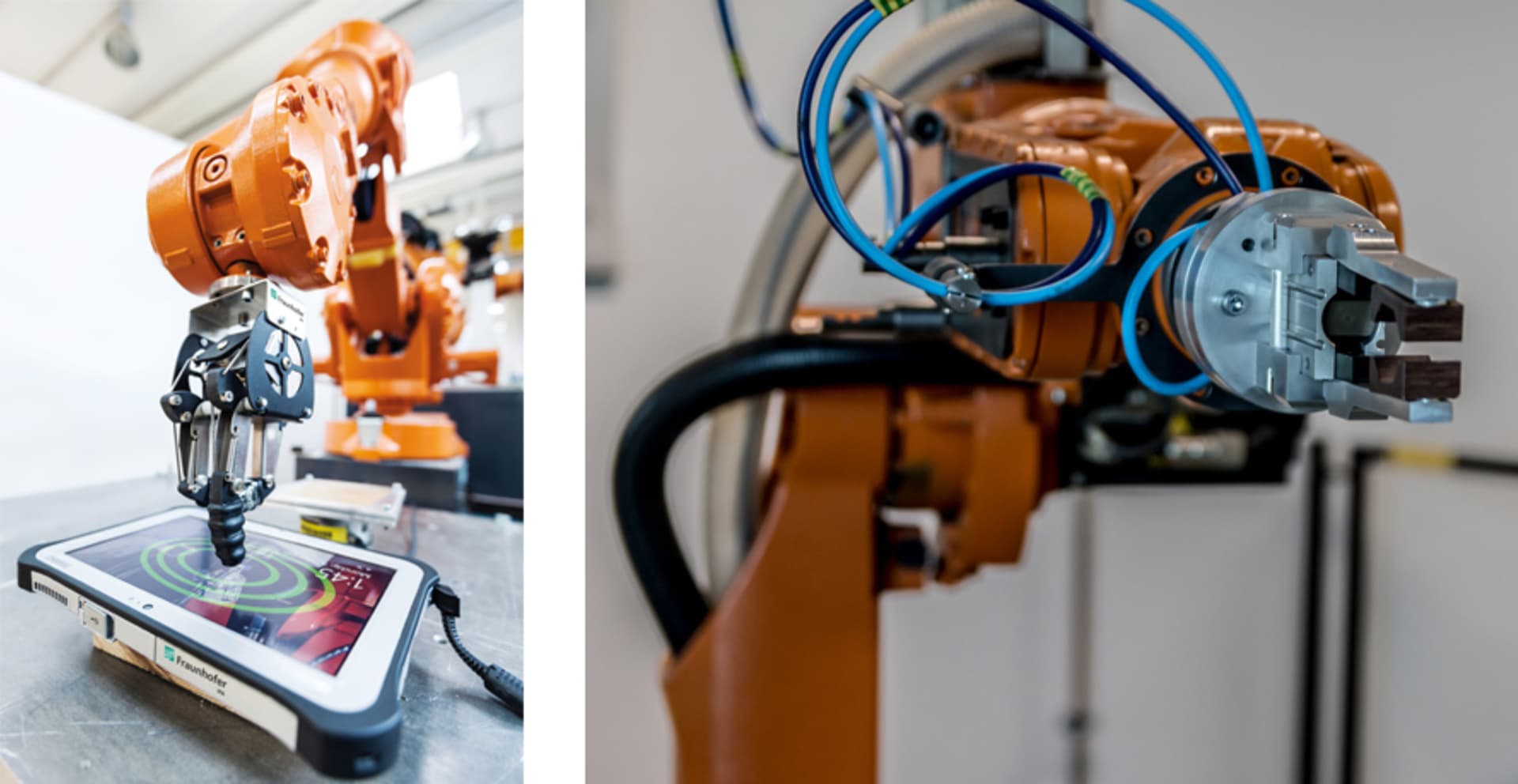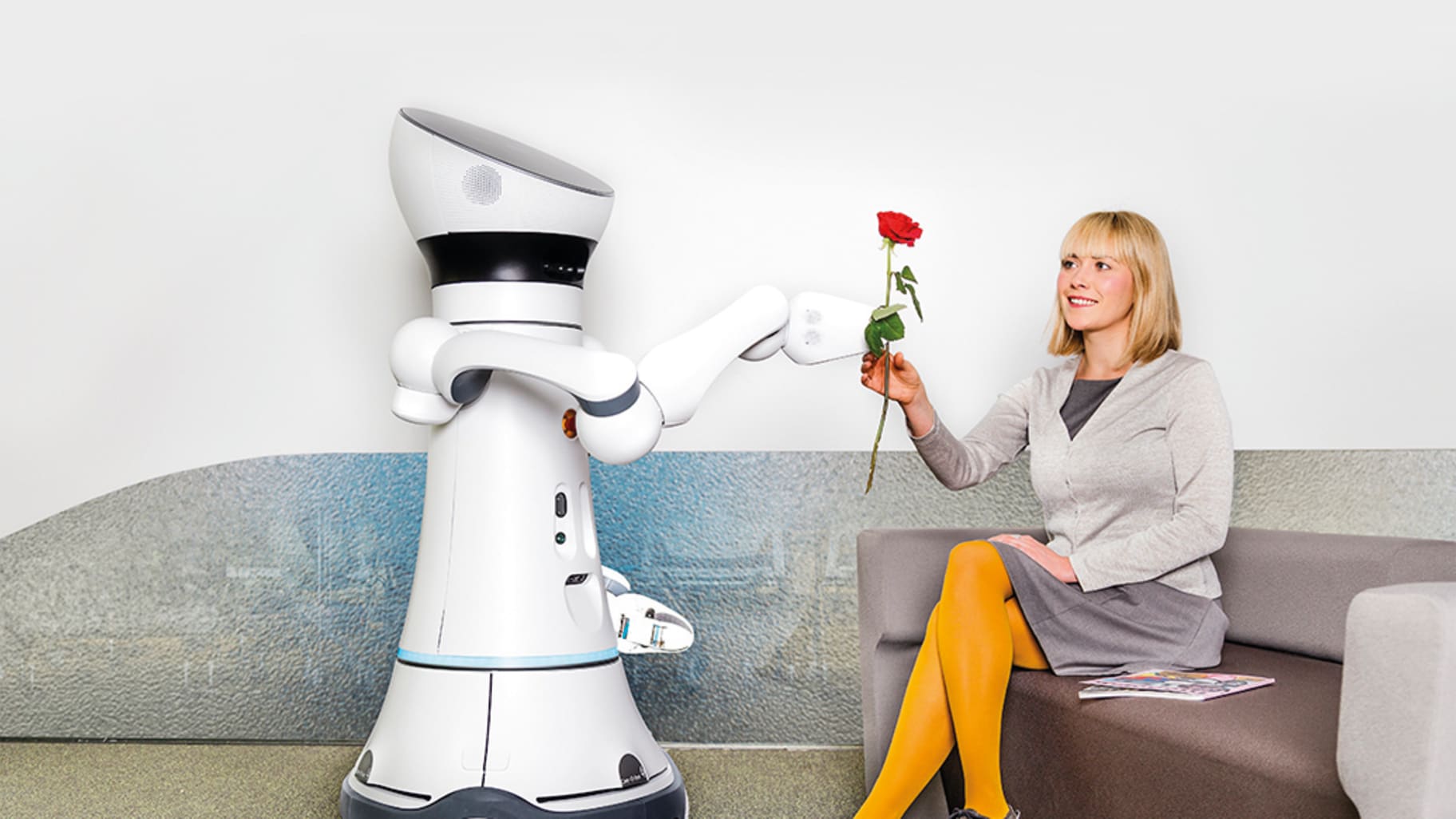Herr oder Diener? Wie Roboter unseren Alltag verändern.
Imagine you are currently attending your Industry trade fair. Your stomach tells you it is time to eat. At the food counter, you are greeted by a friendly face: “Good morning, Mr/Ms XY. You look tired and hungry. May I suggest a grilled sausage and a measure of your favourite beverage?” You order. “Thank you, Mr/Ms XY, we have already deducted the amount from your account.” A freshly grilled sausage and a caffeinated refreshment appears before you. In this situation, there was only one single Homo sapiens – you! I beg your pardon? No, your eyes are not deceiving you: The kind ‘face’ of the ‘service’ is provided by SociBot, a robot for customer driven interaction which, apart from the ability to accept commands, can also discern the mood of the person it is facing.
If it is connected to Facebook, for example (the provider of the face image), and to the Google Hands Free payment service, the customer experience rolls out entirely without your intervention. Wasn’t there something else? Yes, there was: the sausage. This was prepared for you by FZI grill robot on instructions from SociBot. Enjoy! Welcome… back to the current decade! Of course, this example is – still – pure fiction. But such things are already possible today, and in some cases, they are a reality, e.g. robots that vacuum your living room or mow the lawn.
Real and digital world merge
At present, strong trend fields interact with each other. Further developed and interactive control systems are being merged with innovative drive systems. The interplay allows new manufacturing techniques, products and services that seemed impossible until recently. During virtually every process in industry and commerce, data streams are being recorded, saved, processed and then used in places which are in no way connected with the way they were generated.
All this is driven primarily by the demand for optimisation – in other words, the survival instinct. In a commercial environment, this applies predominantly to the economy and profit. In private life, comfort and spare time are the usual drivers, if we disregard image cultivation as a factor. In this way, a growing reliance on robotics has crept into everyday life – sort of through the back door.
Machines are now even given pet names, and not infrequently, even a staff identity card. Many studies reliably suggest that workers in a cooperative working environment rely more on mechanised colleagues or superiors than their human counterparts. In the same way, we can assume that with robots, we can eliminate mistakes. In this way, Bossard’s automatic merchandise management system will automatically order all the small parts as and when they are used. Counting errors: None. Excess inventory: Also, none. Nevertheless, robots are man-made. Algorithms do not generate themselves, they need programming – and that somehow makes code human. But this in itself is not the end.

Robots vs. Humans?
Sound like a horror film? You might see it that way. Indeed, it is nothing short of a revolution of the modern business world. The same thing may have been said 20 years ago, but today machines are able to see, to talk to one another, to understand and even to ‘think’. If SAM, the brick-laying robot places one brick above the other and the hole drilling robot moves in from the left in three-shift operation to position the wall plugs in the right places, all becomes clear: where work is onerous, dangerous or prone to human error, the corresponding jobs disappear. According to the American Trucking Association, in 2010 some 3 million truck drivers and 6.8 million people in their immediate environment were employed in the USA alone.
Therefore, driver-less cars or trucks will eventually provoke a social discussion. Accordingly, a simple link with IBM’s computer program Watson will soon become more than just an ‘access’ facility to a super computer. At this point, man and machine will meet in a totally different context. Many ‘normal’ activities and trades will die out or change dramatically. This is not the worst that can happen, provided that there is a strategy to deal with this change – a strategy which the majority of companies can support. This may include qualification measures – out with repetitive work and in with employees who can think and act independently.
We should not forget the changes in the work place, or reorganisation of the work. Here it would certainly be worthwhile to use existing aids. KapaflexCy of the Fraunhofer Institut für Arbeitswirtschaft und Organisation is exemplary here. A smartphone app (the so-called shift doodle) is used to organise shifts of company employees to suit pending work, with self-organising capacity control. Incidentally, data were used here, and not sparingly. Despite this, during a trial operation by BorgWarner in Ludwigsburg, it was perceived as a positive approach because it offered many advantages to all concerned. And that’s what matters. The use of data becomes a question of fate.
Don’t be afraid of the digital future
Those who manage to establish utilisation and business models, which, in addition to the core benefits, offer a feeling of security to all those involved, will be ahead of their competitors. And when it comes to the subject of data security, we have opportunities in Germany. But we need to use them. To achieve success, everyone must be prepared to expose themselves to innovation. This means testing, trying, getting things to run. It requires an optimistic attitude to data – not digital phobia. It means driving the competition, not just playing catch-up. It means having leaders and employees who do not dismiss “Industrie 4.0” as a washout, but who actually explore “Industrie 4.0”. Yes, it will undoubtedly involve making an effort. It will also become incredible, inconceivable. The opportunities are endless, and they offer many diversions…

Bild: Fraunhofer IPA
Robots become more human
Now for the good news: Megatrends do not appear overnight. But, in truth, we are in the middle of it all, and robots no longer look like robots; they are sexy, and not infrequently among us, they are virtual. Machines will become more human, and in future they will hardly be separable. And yes, man will become more machine-like – at least, if he fails to face such questions. There will no longer be such a thing as average. I will either be made redundant by robots of every kind, in which case my task offers infinite scope for development, or I will have to compete with their pace. It is by no means out-of-this-world for people to look these possibilities in the face. Why don’t we become a little more robot-like? The demands are evidently increasing.
The first upgrades for man are already available. Starting with the chip under the skin for opening doors and identification, by means of computer-controlled exoskeletons, up to support at work, or when we have health problems. Or even – and this may be a futuristic dream – to improve our own individual performance. Maybe you’ll be going to see a theatre production tomorrow in which one of the actors is a robot, the barman in your local pub might be powered by servo motors, or you might be on the phone to your insurers and ask, “Hey, are you a robot?” Even if the answer is “No”, machines are becoming more human – and what about humans? We have one thing that makes us superior to technology; the ability to think. So, let’s take time to think, and let’s do it well.



